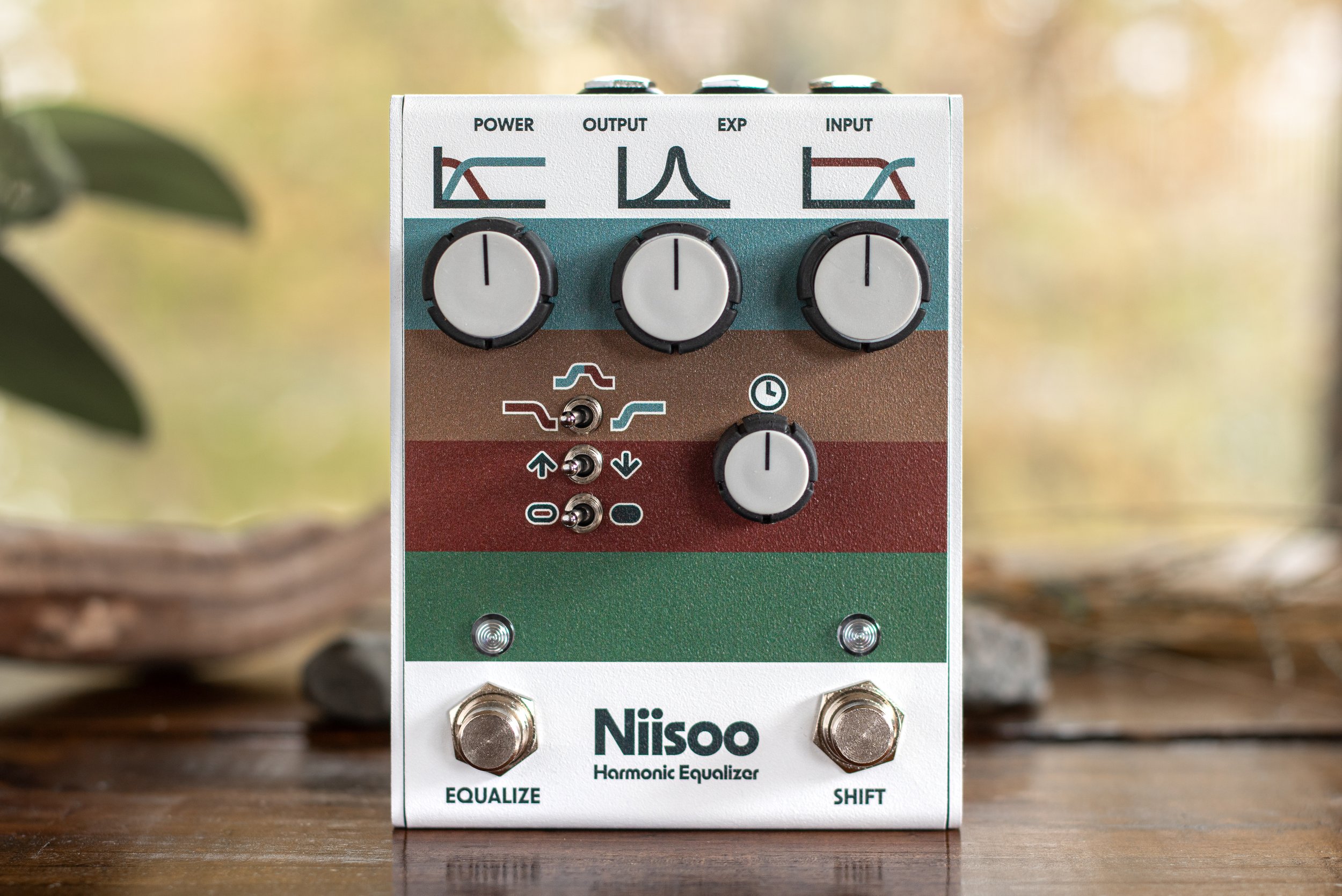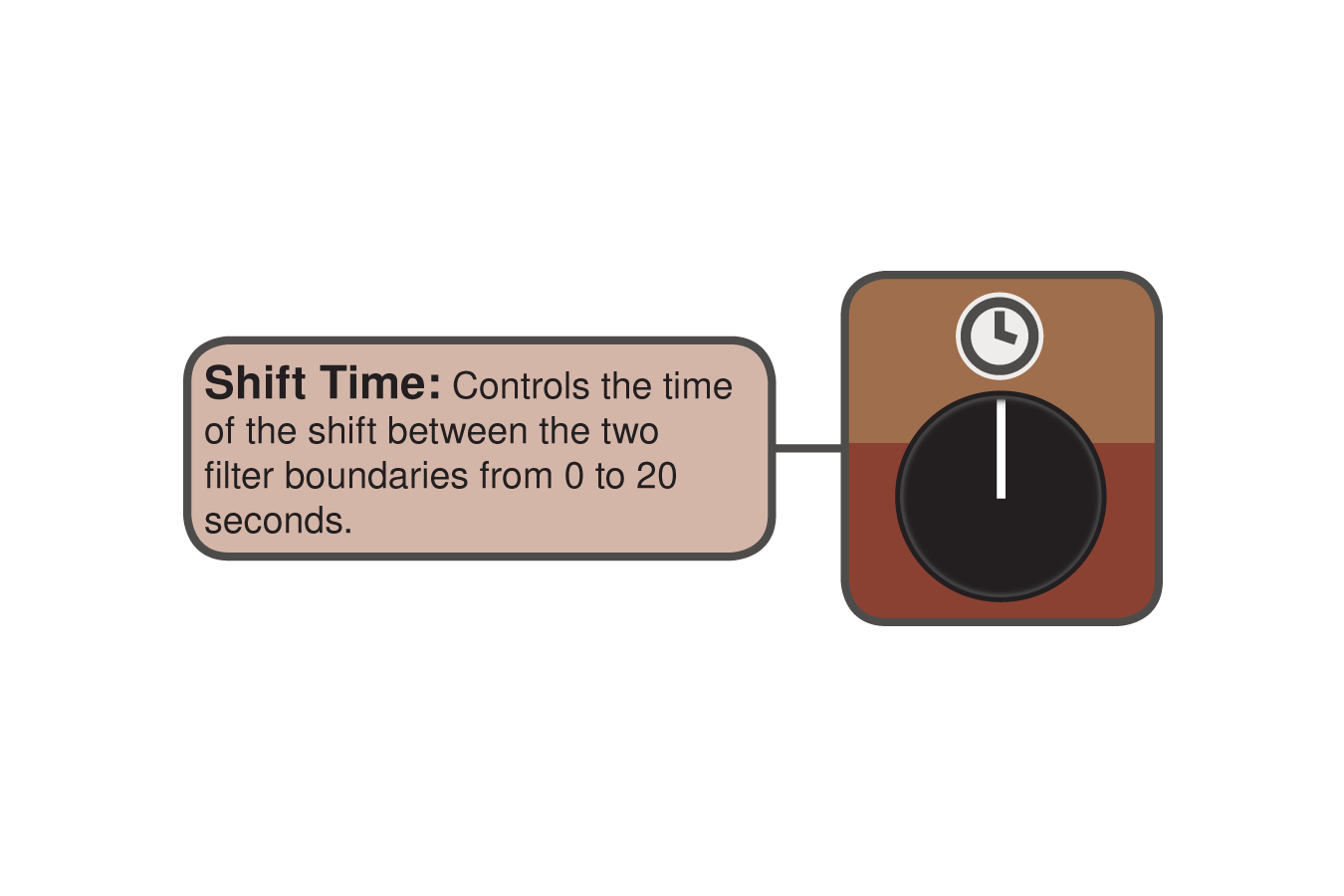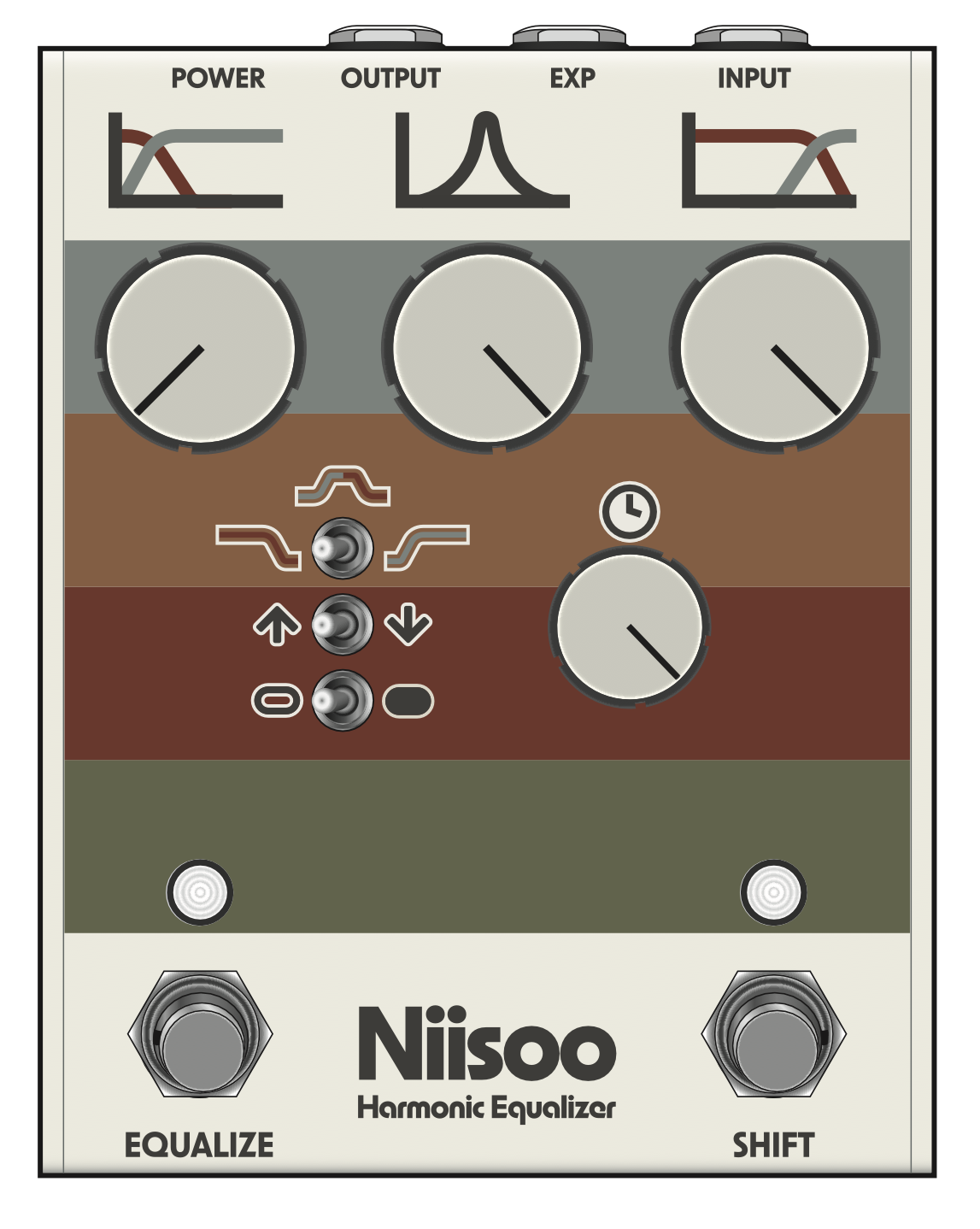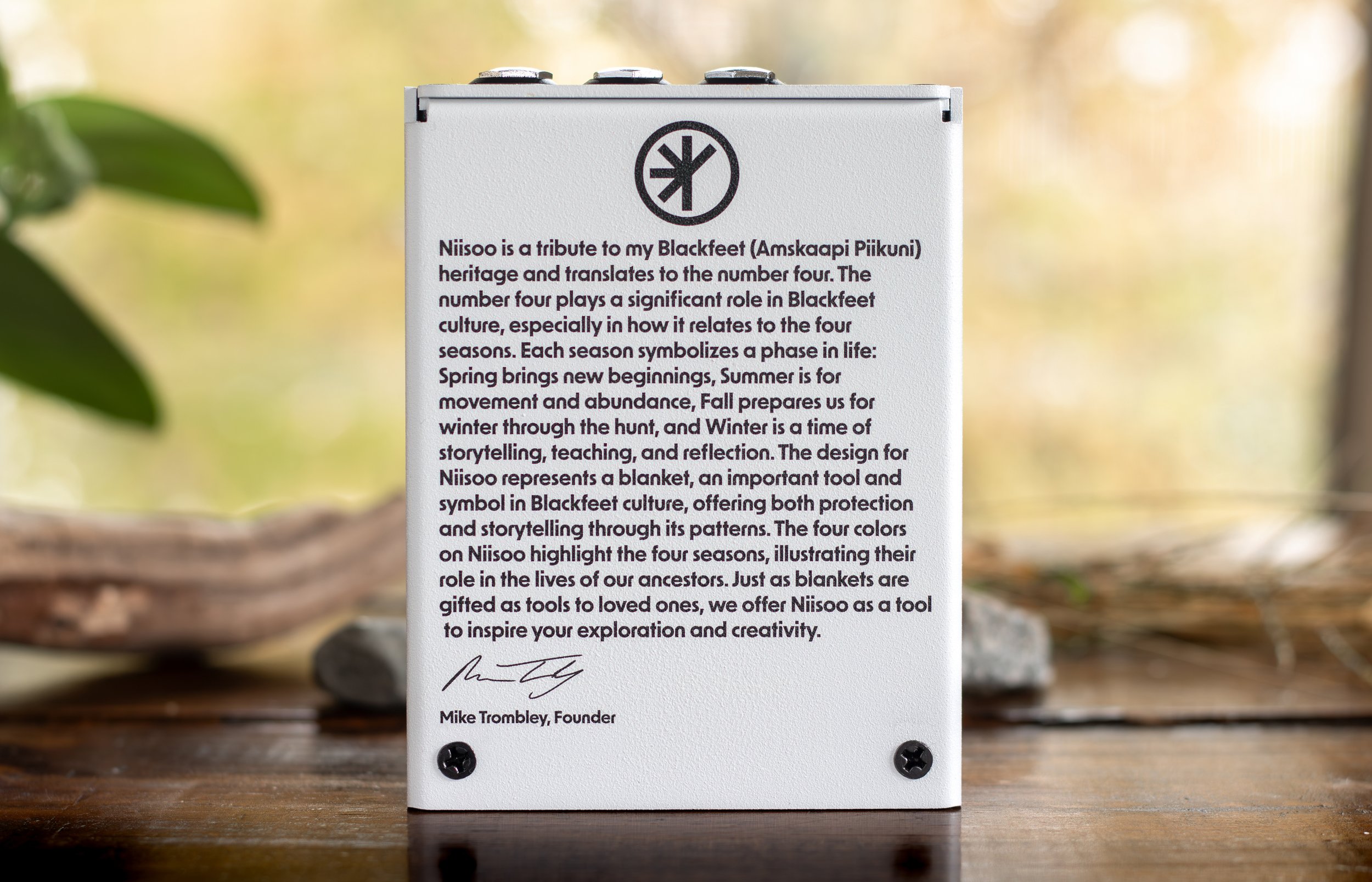Nissoo - Harmonic Equalizer.
Another step into the unknown.
Things are getting weird, and we’re not going to lie – we love it. As both an engineer and a creative, you constantly battle between two forces: the familiar and the unknown. The familiar is cozy and calm; you know where you are and how things are going to work. But another word for this could be complacency. It’s not a good place to be if you want to grow or fully experience life.
On the other side is the unknown. It’s in this wilderness where you truly grow and learn more about yourself and your craft. We at NativeAudio are currently in that wilderness and have been for the past year. Since diving into the unknown, we’ve created things like the War Pony and Frybread—pedals that break away from the “standard” NativeAudio lineup. And honestly, I think we’re going to be hanging out here for a while.
As the owner of an effects pedal company, I’m having way too much fun. So, as we continue to explore this wilderness, we’re excited to introduce our newest pedal, Niisoo (nee-sue).
Nissoo Harmonic Equalizer.
The Niisoo Harmonic Equalizer is a versatile tone-shaping tool designed to provide a diverse set of interactive analog filter options. Its dynamic interface allows for instant or timed recall of two user-defined frequency points, adjustable from 0 to 20 seconds. Niisoo employs advanced fourth-order filtering with resonance control, offering a fresh take on classic analog synth technology. With a rich palette of sounds—including lo-fi textures, filtered tremolo, classic wah, frequency shifting, and powerful equalization—Niisoo is perfect for both live performances and post-production use.
A new approach to synth technology.
I’ve always found the synth world fascinating. There’s something unique about how synth musicians approach their creativity and craft their sound. What I find so cool is how the musician’s interaction with the effects and sound shaping is entirely different in this realm. To me, it feels like this approach is quite different from the world of effect pedals, and there’s a creative bridge that we’re missing.
I wanted to bring that wild, experimental approach to sound shaping into the world of effect pedals, but deliver it in an intuitive and unique way that hasn’t been done before. As we dive into Niissoo, I believe you’ll start to catch our drift and see that it’s not just a new take on familiar sounds, but also an introduction to a whole new range of tonal possibilities.
All analog, no nonsense.
Niissoo is a fully analog pedal, meaning no digital tricks are applied to your signal. What you hear is 100% pure analog warmth and goodness. So, how does Niissoo achieve its sound, and what is it comparable to?
Niissoo uses voltage-controlled amplifiers (VCAs) arranged in a filter configuration. Specifically, four VCAs are placed in series to create a fourth-order filter with multiple configurations. If you’ve ever used a synth with low or high cutoff, you’re probably familiar with sweeping the filter while playing to produce a wide range of tones. With Niissoo, we’ve taken that concept and adapted it into pedal form, giving you complete control—whether you're playing guitar or keys—over a wide range of subtle to extreme frequency manipulations across the entire audio spectrum.
How does Niisoo work?
At the heart of Niissoo, you start by selecting two frequencies—referred to as the lower and upper bounds. These define the range in which your filter sweep, or "shift," takes place. You then customize the filter by choosing one of three modes (low, band, or high) and adjusting the resonance (rez) to give the filter more character, making the effect more pronounced. After setting your range and filter, you choose the shifting mode: latch or momentary. In latch mode, a quick press will hold the filter shift at the ending boundary, while in momentary mode, the shift continues if you hold the switch. You can also set the duration of the shift, from instant to up to 20 seconds. Now the magic happens—just press or hold the shift switch, depending on the mode you’ve chosen, and you now have an INSANE filter-sweeping engine with the simple press of a button.
Let’s get nerdy.
Now that we know the basic operation of Niisoo, let’s dive into the super nerdy details of each parameter on Niisoo:
Filter Mode
Lower and Upper Boundary
Rez
Shift Direction
Latch/Momentary Shift
Shift time
Expression control
Filter Mode.
Before the signal enters the filter mode, we start with a full-spectrum input. Full spectrum? Yes, that means the entire audio range from 20 Hz to 20 kHz. This setup ensures that whether you're playing bass, keys, or running a full audio track from your soundboard into Niisoo, all lows and highs are preserved. This approach maintains a clean frequency slate to work with when modulating the tone using one of the three filter modes: low-pass, band-pass, and high-pass.
During the development of each filter mode on Niisoo, we discovered that each filter performs best within a specific audio spectrum range. To maximize their effectiveness, we fully customized each filter mode, optimizing them for ideal control and a smooth transition between lower and upper bounds. This ensures that, regardless of the mode you’re using—low, band, or high-pass—you can experience it at its fullest potential.
Lower and Upper Boundary.
The lower and upper boundaries are two distinct frequency points within the filter mode that you can set. As the names suggest, one point focuses on the lower end of the filter mode’s range, while the other is set at the upper end. By adjusting the shift between these two points, you’ll experience all the frequencies in between as it shifts from one point to the other.
Depending on the mode you’re in—low-pass, band-pass, or high-pass—you’ll hear a specific frequency range. In low-pass mode, the lower boundary starts with all highs and most of the signal removed; as you shift toward the upper boundary, the filter gradually opens up until you reach your original bypass tone. In high-pass mode, the lower boundary starts with your bypass tone and loses the bass frequencies as you approach the upper boundary, resulting in an almost lo-fi or telephone-like sound. Band-pass mode combines aspects of both ranges: at the lower boundary, you get a thick, warm sound that thins out as you move toward the upper boundary.
Rez.
Now that we’ve set our filter mode and boundaries, it’s time to add some spice with the rez control. The rez control takes the filter output and feeds it back into itself, giving Niisoo a ton of range—all the way up to self-oscillation, which is a fascinating sonic space to explore. This feedback loop creates a more dramatic effect, making the filter sound even more pronounced. For low- and high-pass filters, you’ll get a wild, swooping sound, while the band-pass filter takes on a distinct, quacky character. Just like seasoning a meal, use the rez control to flavor your tone to taste.
Shift direction.
Another valuable parameter is shift direction, which determines the starting point of Niisoo’s filter sweep. The shift direction is labeled with an up arrow for lower-to-upper operation and a down arrow for upper-to-lower operation. Setting this thoughtfully is key, as it shapes how the filter transitions. You can start with a tone close to the bypass sound and dive deeply into the selected filter, or begin fully immersed in the filter effect and gradually surface back to the bypass tone. Another way to visualize this control is like a wah or volume pedal—you can choose to start from the heel and move to the toe position, or vice versa. The choice is yours, expanding the range of sounds you can create with the filter.
Latch and Momentary shift.
You shift between the two boundary positions using the shift control and depending on how you have the switching mode configured, your experience will vary. The latch mode on Niisoo is indicated by the oval that is not filled in while momentary has a filled in oval. Latch operation operates by pressing and releasing shift switch quickly to toggle between filter boundaries. The momentary operation works by holding the shift switch to momentarily shift between filter boundaries and releasing to return to starting boundary.
Shift time.
Shift time does exactly what it says: it determines the amount of time it takes to transition from one boundary to the other. Shift time is indicated by the knob with the clock graphic. Setting the shift time is valuable because, depending on your situation, you might need a quick transition or a longer one.
Using an immediate shift time is perfect for when you want to toggle between two preset filter settings. For instance, you can set Niisoo to low-pass mode and bounce between a filtered sound based on how bright your guitar is. A medium shift time works well with momentary shift switching, as it mimics the effect of using an expression foot controller to perform a sweep. On the other hand, a long shift time is ideal for creating more dramatic sweeps, allowing for a slower and more gradual shift in tone—great for intros or outros in a song.
Expression control.
Niisoo is the first product in our company’s history to feature an expression input. This input allows for manual shifting between lower and upper boundaries. Instead of using the shift control, you can take control into your hands with your favorite expression controller. The expression control is TIP-active and accepts a range of resistance values from 10kΩ to 100kΩ. When you use the expression controller to manually shift, your frequency sweep will occur within the range set by the lower and upper boundary controls.
A great way to utilize the expression input is if you want Niisoo to function as a wah pedal. Simply choose an expression foot controller and set up Niisoo’s filter engine to operate in band-pass mode. The advantage of this configuration, unlike most wah pedals, is that you can now set the extremes of your wah sound using the boundary and rez controls. Additionally, if you prefer to sweep the wah in a different manner than the standard heel-to-toe position, flip the shift direction switch, and you’ll be sweeping your wah in the opposite direction!
Suggested settings.
It’s really hard to unpack Niisoo’s full expressive sound in a quick write-up because it’s truly something you have to experience for yourself. However, we’ll leave you with a couple settings that’ll help you get right in the flow of things!
You really are focused. - Treble booster!
Use Niisoo in high-pass mode before overdrive, distortion, or fuzz to trim excess low end and act as a treble boost, giving your dirt a more focused tone. How to use: Start with both the lower and upper boundaries set to 12, then adjust to match your specific dirt pedal. When using the dirt pedal for rhythmic playing, stay on the lower boundary. Shift to the upper boundary when you're ready for treble-boosted lead tones. We use latching mode, so you don't need to keep your foot on the pedal to maintain the upper boundary.
Wah are you doing? - Instant wah pedal.
One of the frustrations with traditional wah pedals is the lack of customization—you get what you get. Thankfully, Niisoo in band-pass mode acts as a fully customizable wah pedal! You can adjust the low end, Q, highs, and sweep time, making it perfect for dialing in all your classic wah tones. How to use: This setup uses momentary switching, and we've set a good shift time to give you a smooth wah-like sweep. However, feel free to plug in an expression pedal for the full wah experience. Adjust the lower and upper boundaries to suit your taste. If your wah has too much bass, turn the lower boundary clockwise. If it's too bright, turn the upper boundary counterclockwise.
As my synth gentle sweeps. - Synthy low-pass filter.
This is great for adding an intro or outro to a song. It creates a long, pronounced sweep that, when starting at the lower boundary, sounds like you're outside a building with music playing. As you move toward the upper boundary, it's like the door slowly opens to reveal where all the fun is happening. It sounds especially rad with aggressive, fuzzy tones—like our Frybread Fuzz—for a full, synth-like effect. How to use: The more dramatically you set the lower and upper boundaries (min/max), the heavier the sweep you'll experience—adjust them to your taste. The real magic lies in the shift time. Longer shift times create a more dynamic sound as your playing and tone continue to evolve over time. We recommend using latching mode for longer shift times, so you can focus on your riffing while Niisoo handles the rest.
About the artwork.
Niisoo is a tribute to my Blackfeet (Amskaapi Piikuni) heritage and translates to the number four. The number four plays a significant role in Blackfeet culture, especially in how it relates to the four seasons. Each season symbolizes a phase in life: Spring brings new beginnings, Summer is for movement and abundance, Fall prepares us for winter through the hunt, and Winter is a time of storytelling, teaching, and reflection.
The design for Niisoo represents a blanket, an important tool and symbol in Blackfeet culture, offering both protection and storytelling through its patterns. The four colors on Niisoo highlight the four seasons, illustrating their role in the lives of our ancestors. Just as blankets are gifted as tools to loved ones, we offer Niisoo as a tool to inspire your exploration and creativity.
As always, a thank you.
Filtering has been an integral part of the music industry since its inception. Over time, musicians have discovered various ways for their instruments to interact with filtering. When we considered how to approach a filter, we aimed to do it in a unique and engaging way. I genuinely believe we achieved this with Niisoo, and I hope you have the opportunity to experience its innovative approach to your sound.
Once again, thank you for joining us on this journey as we explore these sounds together.
Much love.
Let’s make some noise!
Now that we’ve explored the possible, let’s go and create the impossible.













